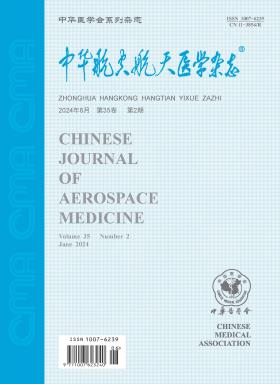Study on 3-D digital measurement of posterior neck shape of fighter pilots
引用次数: 0
Abstract
Objective To obtain the 3D shape data and features of 50th percentile posterior neck length in Chinese pilots.Methods The posterior neck length was measured in 150 fighter pilots by developed probe array and then 32 fighter pilots who were in accordance with 50th percentile posterior neck length were selected based on these 3D digitized posterior neck measurements.Results The method of digitized measurement was established.The range of posterior neck length was from 81 mm to 168 mm,the mean length was 127.3 mm in 150 pilots.In 32 fighter pilots with 50th percentile posterior neck length,the length range was from 120 mm to 123 mm,the mean length was 121.4 mm.The least square fitting curve was got then and 3D model was established.Conclusions The developed equipment and method are practical and effective.The results can be applied to the 3D analysis of posterior neck shape features and to the design of the neck support and head rest of ejection seat. Key words: Posterior neck; Anthropometry; 3D digital measurement战斗机飞行员后颈形状三维数字测量方法研究
目的获取我国飞行员后颈50百分位长度的三维形态数据及特征。方法采用研制的探针阵列测量150名战斗机飞行员的后颈长度,根据后颈三维数字化测量结果选择符合后颈长度第50百分位的32名战斗机飞行员。结果建立了数字化测量方法。150名飞行员后颈长度为81 ~ 168 mm,平均长度为127.3 mm。32名后颈长度为第50百分位的战斗机飞行员,后颈长度范围为120 ~ 123 mm,平均长度为121.4 mm,得到最小二乘拟合曲线,建立三维模型。结论所研制的设备和方法实用有效。研究结果可用于后颈部形状特征的三维分析,以及弹射座椅颈部支撑和头枕的设计。关键词:后颈部;人体测量学;三维数字测量
本文章由计算机程序翻译,如有差异,请以英文原文为准。
求助全文
约1分钟内获得全文
求助全文
来源期刊

中华航空航天医学杂志
航空航天医学
自引率
0.00%
发文量
2962
期刊介绍:
The aim of Chinese Journal of Aerospace Medicine is to combine theory and practice, improve and popularize, actively advocate a hundred flowers bloom and a hundred schools of thought contend, advocate seeking truth from facts, promote the development of the related disciplines of aerospace medicine and human efficiency, and promote the exchange and penetration of aerospace medicine and human efficiency with other biomedical and engineering specialties.
Topics of interest for Chinese Journal of Aerospace Medicine include:
-The content of the journal belongs to the discipline of special medicine and military medicine, with the characteristics of multidisciplinary synthesis and cross-penetration, and mainly reflected in the aerospace industry, aerospace flight safety and efficiency, as well as the synthesis of special medicine, preventive medicine, environmental medicine, psychology, etc.
-Military aeromedicine (Air Force, Navy and Army aeromedicine) and civil aeromedicine, with a balance of aerospace medicine are the strengths of the journal.
-The change in aerospace medicine from a focus on promoting physiological compensatory adaptations to enhancing human performance under extreme environmental conditions is what the journal is helping to promote.
-The expansion of manuscripts in high altitude medicine is also a special emphasis of the journal.
 求助内容:
求助内容: 应助结果提醒方式:
应助结果提醒方式:


